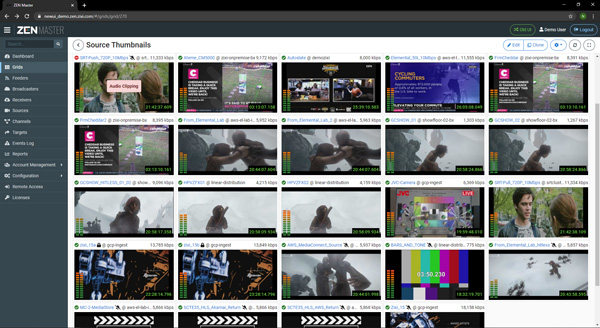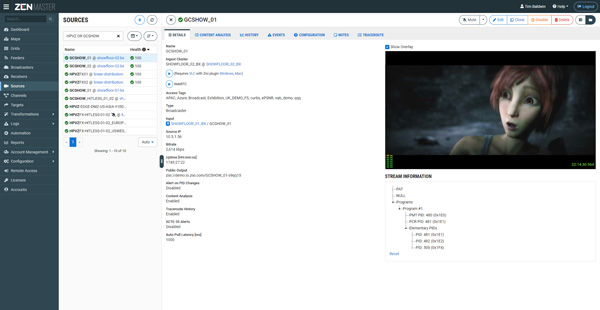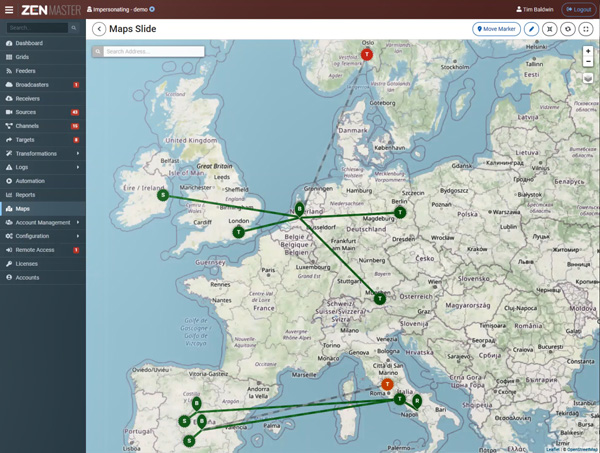
Centralised stream management
In 2020, Nielsen compiled a report on the impact of stay at home rules on media consumption habits for workers, in response to the COVID pandemic. The report found the most popular activity was listening to music on an AM/FM radio station or streaming services, with 40% of workers in the survey listening daily, followed by watching TV or streaming content during a work break, with 33% watching every day.
Zixi, a specialist developer of live video distribution over IP and a network-aware codec, believes that this rise in content streaming, specifically live streaming, is behaviour that is unlikely to change in the foreseeable future. Therefore, it is important for the media and entertainment industry to adapt and embrace new techniques and systems in order to prosper.
In this article John Wastcoat, SVP Alliances and Marketing, identifies three key characteristics that broadcast streaming infrastructures need in order to support successful, agile media workflows. These are inherent agility, universal interoperability and data-driven capabilities.
Agility and Seizing Opportunity
John said, “Modern streaming workflows have to be able to respond quickly to changing market dynamics, as well as be able to seize new opportunities as they arise. For that, they need to be based in the cloud. Software-defined and virtualised workflows supply a degree of responsiveness that is impossible to replicate in any other manner. For that reason, we are seeing a growing number of large-scale media enterprises pivot towards end-to-end, cloud-based workflows.”

Channel diagram
Furthermore, five major advantages of the cloud are influencing their decisions – greater flexibility, cost savings, an increase in reliability, faster time to market and the ability to support a virtualised and remote workforce. The change in the workforce, especially, has become a defining feature of the post-pandemic economy.
Zixi said that each of those advantages is a compelling reason to move to the cloud on its own. “When added together, it’s easy to see why Zixi’s poll in April 2020 on media preparedness for the pandemic found that only 35% of future infrastructure build-outs were planning a hardware-defined infrastructure. 65% were looking at a software-defined infrastructure and, given the pandemic’s ability to accelerate most factors in this area, we would be surprised if that number wasn't already higher.”
Universal interoperability
Any IP, any protocol, any infrastructure – the most effective new streaming workflows will be IP-based and portable. Zixi regards the move towards IP workflows throughout the media industry as a generational shift, driven by numerous different factors, from changes in viewing options to the adoption of hybrid network workflows, increased bit rates, enhanced monetization opportunities and others.
It is also being enabled by the increased reliability, adoption and democratisation of managed and unmanaged IP networks over and above legacy transport methods. Managed and unmanaged IP networks are defined to include, internet, leased fibre – dedicated fibre optic services delivered directly to the premises, cellular including 5G, and IP satellite, which converts satellite TV signals to IP and distributes them in the home network to TVs with an integrated SAT-to-IP client.

Monitoring and reporting
“When handled correctly, public IP operates with higher resiliency, higher reliability, lower latency, higher quality and considerably more flexibility than traditional methods,” said John. “If you look around the industry, that is where the momentum lies. Other transport methods have played, and still play an important part in the overall development of IP-based workflows, but they are essentially becoming evolutionary dead-ends for new world media workflows that are nearing the end of their usefulness as IP becomes the dominant route to connectivity.
5G in Public IP
“It’s important to recognize the critical importance of 5G in public IP as well. 5G will drive $1.3 trillion of revenues in the media and entertainment space by 2028, completely reshaping the media landscape and ensuring that if companies fail to support it, they risk failure or even extinction.”
Further to that, cloud – that is, extending the existing cloud to 5G / 4G LTE and creating multi-access edge computing (MEC) – is critical to successful 5G deployment, as are the other four elements of streaming: content, carrier, cellular and consumer.
Producing high quality content is the starting point for broadcasting content at the highest quality of experience (QoE). The carrier supplies the critical fibre infrastructure between regional and global MECs. We also need a high bandwidth, ultra-low latency cellular network serving as universal edge, and mobile consumers ready to create and deliver 4K live content.

Visibility and analytics
“We've spent the past year at Zixi working on a deployment with a major broadcaster for delivery over Verizon 5G networks using AWS Wavelength Zone technology to allow distribution of 4K UHD streams to commercial targets at super-low latency without the need for satellites. As a result, there is now a defined architecture with AWS and Verizon that includes on-premises devices (5G routers) across all segments with Zixi. We expect more broadcasters to head down this route rapidly.”
QoE Data – a Reactive vs Proactive Approach
Finally, it is important to consider the role of data analysis in ensuring QoE and other streaming characteristics, involving many complicating factors. John said, “Data overload can lead to too many false alarms, leaving organisations unsure of what is important and what is not, but a reactive approach on its own can prove costly and stressful.
“What is required is better Root Cause Analysis (RCA) to swiftly understand the causes of instability and failure, to get ahead of them and prevent them from happening in the first place. Artificial intelligence and machine learning can have a major impact on this challenge – correct application reduces noise and costs, improves the accuracy of RCA, drives operational efficiency, and enables a proactive approach to streaming issues — enabling users to be alerted to problems before they occur.”
Automated root cause analysis uses intelligent machine learning algorithms to identify patterns in an organisation’s processes. Automatically identifying the root causes of process problems – through data – helps lead to optimisation based on facts instead of speculation.

Cloud-based control plane
AWS’ Wavelength infrastructure is optimised for mobile edge computing applications. Wavelength Zones deployments embed AWS compute and storage services within the CSP’s datacentres at the edge of the 5G network. As a result application traffic from 5G devices can reach servers running in Wavelength Zones without leaving the network, avoiding unnecessary latency and taking better advantage of 5G networks. AWS Wavelength Zones are available on Verizon’s 5G network, in ten cities across the US.
Momentum
Though the momentum behind broadcast streaming is undeniable, John notes that a potential exists for deployments to be too restrictive to ensure enough return on investment, especially when considering future developments. He said, “By ensuring they engage with partners that supply services with inherent agility baked in, the universal interoperability necessary to accommodate public and private IP, hybrid IP and 5G networks, and the data-driven capabilities to ensure reliability and QoE, broadcasters and other media companies can be confident that their streaming services will meet and exceed consumer demand for streaming content, now and into the future.” zixi.com




